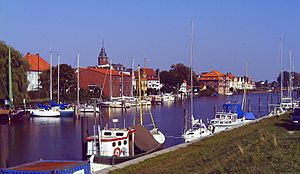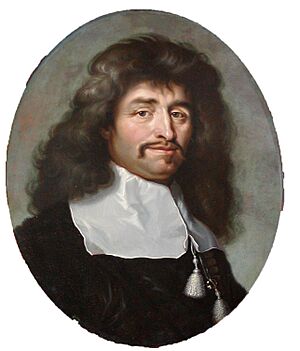Glückstadt facts for kids
Quick facts for kids
Glückstadt
|
|||
|---|---|---|---|

Northside of Glückstadt harbour
|
|||
|
|||
| Country | Germany | ||
| State | Schleswig-Holstein | ||
| District | Steinburg | ||
| Elevation | 2 m (7 ft) | ||
| Population
(2022-12-31)
|
|||
| • Total | 10,885 | ||
| Time zone | CET/CEST (UTC+1/+2) | ||
| Postal codes |
25348
|
||
| Dialling codes | 04124 | ||
| Vehicle registration | IZ | ||
| Website | www.glueckstadt.de | ||
Glückstadt is a town in Germany. It is located in the Steinburg district of Schleswig-Holstein. The town sits on the right side of the Lower Elbe river. This is where the small Rhin river flows into the Elbe. Glückstadt is about 45 kilometers (28 miles) northwest of Altona. It is also part of the Hamburg Metropolitan Region, which is a large area around the city of Hamburg.
Contents
History of Glückstadt
Glückstadt was started in 1617. It was built on marshy land along the Elbe river. King Christian IV of Denmark, who was also the Duke of Holstein, founded the town. He had strong walls and dikes built to protect it. He also built a royal home there.
The name "Glückstadt" means "Luck City" or "Fortune City" in English. King Christian IV wanted the town to grow. He promised people who moved there that they would not have to pay taxes. He also promised them freedom of religion. This meant people could practice any religion they chose.
Because of these promises, Glückstadt quickly became an important place for trade. The king hoped it would compete with the city of Hamburg. Many different groups of people moved to Glückstadt. These included Calvinists, Remonstrants, and Mennonites from the Netherlands. Sephardic Jews and Catholics also settled there.
Wars and Changes
In 1627 and 1628, Glückstadt faced a big challenge. The town was attacked during the Thirty Years' War. Troops led by Albrecht von Wallenstein and Count Tilly surrounded the town for fifteen weeks. But they could not capture Glückstadt.
In 1649, King Frederick III of Denmark moved the main office for Holstein to Glückstadt. This made the area known as Holstein-Glückstadt. Later, in 1773, Glückstadt became the capital of all Holstein lands. This happened when other parts of Holstein joined together.
During the War of the Sixth Coalition in 1814, Glückstadt was blocked by enemy forces. The town had to give up, and its strong walls were torn down. In 1830, it became a free port. This meant ships could trade there without paying many taxes.
Glückstadt stayed under the rule of the Kingdom of Denmark for a long time. But after Denmark lost the Second Schleswig War in 1864, things changed. Glückstadt was taken over by Austria. Then, after another war in 1866, it became part of Prussia. This area was then called the Province of Schleswig-Holstein.
Getting Around Glückstadt
Glückstadt has good ways to travel. In 1845, a train station opened in the town. This station was part of the Marsh Railway line. Today, trains run from Hamburg-Altona station all the way to Westerland on Sylt island.
Glückstadt also has a ferry service. This ferry crosses the Elbe river to Wischhafen in Lower Saxony. The town is also a stop on two special routes. One is the Deutsche Fährstraße, which is a theme road about ferries. The other is the Elbe Cycle Route, a popular path for bikes.
Notable People from Glückstadt
Many interesting people have come from Glückstadt. Here are a few:
- Christoffer Gabel (1617-1673) was a Danish statesman and merchant. He was a very powerful advisor to King Frederick III of Denmark.
- Frederic Louis Norden (1708–1742) was a Danish naval captain. He was also an explorer who studied old buildings and maps.
- Ludvig Manthey (1769-1842) was a Danish pharmacist.
- Adolph Carl Peter Callisen (1786–1866) was a German-Danish doctor and writer of dictionaries.
- August Detlev Christian Twesten (1789-1876) was a Lutheran religious scholar.
- Theodor Olshausen (1802-1869) was a lawyer and politician. He was part of a revolution in 1848.
- August Friedrich Schenck (1828-1901) was a painter. He was known for his beautiful pictures of nature and animals.
- John C. Petersen (1842-1887) was a butcher, farmer, and politician in Wisconsin, USA.
- Rudolf von Willemoes-Suhm (1847-1875) was a zoologist and explorer.
- Theodor Heinrich Engelbrecht (1853–1934) was an expert in farming and geography. He was also a farmer and politician.
- Fritz Lau (1872–1966) was a playwright and author who wrote in Low German.
- Kurt Benirschke (1924-2018) was a pathologist and geneticist. He helped create the Frozen zoo, which stores animal cells to help save endangered species.
- Willi Holdorf (1940-2020) won a gold medal in the decathlon at the 1964 Summer Olympics.
Images for kids
See also
 In Spanish: Glückstadt para niños
In Spanish: Glückstadt para niños








